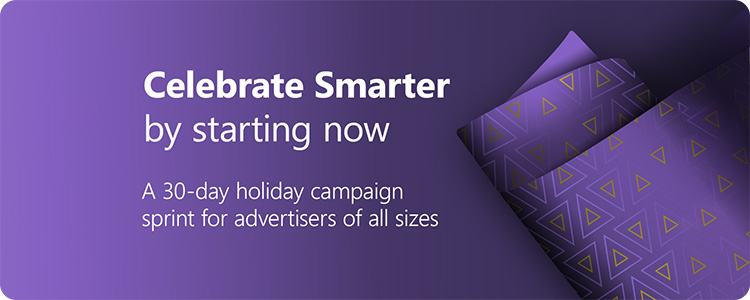Blog post
Celebrate Smarter by starting now: A 30-day holiday campaign sprint for advertisers of all sizes

Holiday shoppers aren’t waiting for Black Friday, and neither should you. Original Microsoft Advertising research shows that over 90% of retail conversions happen outside the Cyber Five window, so what used to feel early in the season is now perfectly timed.1
We’ve designed this 30-day campaign sprint specifically for small and mid-size advertising teams to align planning with real shopper behavior. You’ll find key actions to take during each week during the sprint, or you can adjust the timing or order of operations to what best fits your current and upcoming needs. What matters is that you’re getting a head start.
Regardless of your timeline, if you're accountable for marketing investments and outcomes, this guide will help ensure you feel confident in how, when, and why you're taking action ahead of the holiday season.
A 30-day campaign sprint for early holiday activation
Starting in September, you can build a high-performance campaign roadmap for the 2025 holiday season in six easy steps.
1. Develop a plan to launch full-funnel campaigns by early October
Kick off your sprint with strategic planning to help you win with an early start. Think of October as prime intent-building season: the early planning, gift researching, and wish list creating window.
Microsoft Advertising data shows just how much an early start pays off, with 65% of November conversions and 44% of December conversions originating from clicks that happened in October.2 Launching in October also ensures full shopping journey coverage, as the season increased by over four days (+9% YoY) in 2024.3 Planning your full campaign arc that begins in late September or early October sets you up for success throughout the season.
Week 1 sprint action: Design a campaign calendar to build and sustain momentum early, focusing each month on key goals:
- October: Build early awareness with product info, brand stories, and gift guides.
- November: Highlight value and dial in your early-bird promos.
- Cyber Five: Scale up with deals and urgency around Black Friday, Cyber Monday, and Small Business Saturday.
- December: Drive conversions with fast, free shipping and urgency indicators like countdown messaging for last-minute shoppers.
- January: Wrap up the season with New Year's messaging, targeting gift card redeemers and shoppers looking for late-season bargains.
2. Use generative AI as the engine behind your performance
The holiday campaign season moves fast, with manual processes often pressuring team resources. Advertisers who use smart automation and generative AI to produce creative variations, target shoppers with personalized messaging, and optimize ad placements can enable high-performance results without stretching budgets or staff time. Adopting AI-driven solutions can be an iterative process. Explore different ways of using tools like Copilot to address resource constraints while also making your ads more engaging. For example, you can generate multiple visual options in minutes to test in Multimedia ads or with image extensions to help showcase your brand identity or products.
Week 1 sprint action: Use Copilot in Microsoft Advertising Platform to generate asset recommendations, enhance your copywriting, or develop custom graphics. Then, try partnering your Shopping and Search campaigns with Performance Max for incremental reach and to make AI placements easier.
3. Engage high-value buyers with budgets and value propositions
Consumers are being cautious amid economic uncertainty, with 45% of shoppers planning to reduce their spending.4 While some budgets may be tighter, deals and meaningful values are breaking through to even the most selective buyers. Consumers are hunting for bargains with deal-related search volume up 28% year-over-year.5 Price-sensitivity isn’t telling the whole story, either: 70% of Gen Z buyers are willing to pay more for sustainable gifts.6
Week 2 sprint action: Create a promotional calendar that pairs your deals with high-value signals like sustainability, quality, and brand values. Plan to use in-market retargeting with creative that speaks to both urgency and value.
4. Optimize for conversational shopping
AI search is increasingly changing how people find information, whether through conversational platforms or AI-powered summaries in Microsoft Bing. Shoppers are asking questions, not typing keywords. As a result, natural-language queries in formats like voice search and chatbots are quickly reshaping the way people find information, research products, and even brainstorm gift ideas.
Internal Microsoft data shows Copilot interactions significantly boost purchasing behavior, with a 53% overall increase—and a 194% surge when shopping intent is present—within just 30 minutes.7
Week 2 sprint action: Consider how you might optimize content for conversational search. Build FAQ content, add products to AI-driven search experiences, and pair Search ads with Performance Max to keep your brand discoverable in chat-driven interactions.
5. Create omnichannel journeys from the start
It's easy to default to single-channel campaigns, but Microsoft Advertising data shows consumers don’t shop that way. In fact, 49% of converting paths from last year involved exposure to five different ad formats.8 A strong multi-channel campaign doesn't just drive conversions, it also increases spend. Users who saw both Audience and Search ads spent 35% more than those served only Search ads.9
Week 3 sprint action: Lock in your plans to continue early momentum with a multi-touch campaign using Search, Shopping, Audience, and native placements, all easily managed with Performance Max. Think ahead about layering in remarketing mid‑season to stay top of mind.
6. Extend your campaigns into January for a second wave
Shoppers aren’t done in December. Instead, buyers are heading into January looking for deals, redeeming gift cards they received, and reacting to "New Year, New You" messaging. Last year, January conversion rates in Australia were 15% higher year-over-year.10 Capture an extra bump in sales and turn your Q4 insights into a Q1 2026 kickoff by planning a strong January start now.
Week 4 sprint action: Make time to prepare creative for January early so it aligns with your seasonal narrative. This will help you remarket to holiday shoppers with refreshed messaging and real-time insights after the New Year.
Sprint now to Celebrate Smarter throughout the season
You can set up your holiday campaigns for major success by starting now and using smart strategies to extend budgets. Launch early, lean on AI, layer your messaging, and stretch your season into January for a high-performance season with less stress. A strategic approach frees your time for high-value activities and lays the foundation to delight your customers all season long.
Ready to sprint? Download our full 2025 holiday advertising playbook and Celebrate Smarter checklist today. To learn even more, watch our holiday insights-packed on-demand webinar now.
[1] Microsoft Internal | Retail & CPG Demand | Search & Audience Network
[2] Retail Holiday Query Path 2024 Final Conversion
[3] Microsoft Internal Data. QP Conv 2024 | QP Conv 2023 | Includes Audience ads
[4] Microsoft 1P Survey | 15-minute online study | Must shop online at least 1x per mo. | Fielded April 2025 | US (n=999)
[5] Microsoft Internal | Queries containing deal related terms | O&O Only | US Only | 2023-2025
[6] https://www.firstinsight.com/white-papers-posts/gen-z-shoppers-demand-sustainability
[7] Microsoft 1P Data | Dec 21, 2024 to Dec 31, 2024 | Global | Edge users | 30 minutes before and after Copilot interaction. Measured based on assumed purchases from URL address.
[8] Microsoft Internal | Query Path Holiday 2024, Text ads = RSA, Legacy EXTA, Legacy Text
[9] Microsoft Internal Data, Sept 2024 – Jan 2025, Retail UET conversion advertisers only, Advertiser reported revenue.
[10] Microsoft Internal | Retail & CPG Demand | Search Network
Your input makes us better
Take our quick 3-minute survey and help us transform your website experience.






